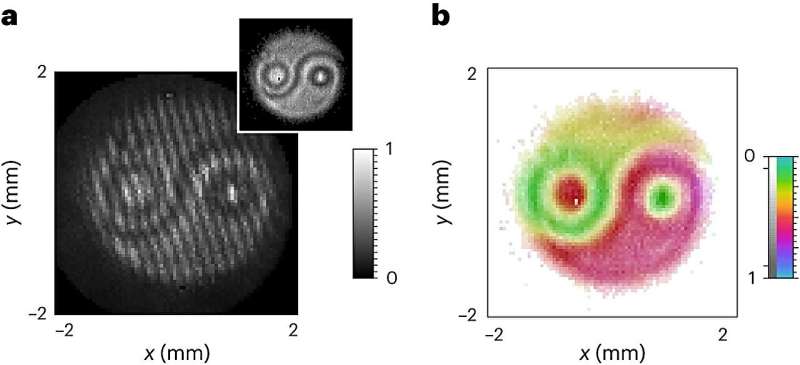August 26, 2023 report
This article has been reviewed according to Science X's editorial process and policies. Editors have highlighted the following attributes while ensuring the content's credibility:
fact-checked
peer-reviewed publication
trusted source
proofread
Saturday Citations: Comparing teenagers to bonobos, babies to dogs, ancient cats to modern cats. Plus: Photons!

This week, scientists contemplated teenage hormones, described cat noises, visualized photon entanglement and—oh!—landed on the moon.
Moon popular: The Indian Space Research Organization landed a spacecraft near the moon's south pole this week, deploying the Chandrayan-3 rover just hours later. All scientific instruments in the lander and rover were activated and the mission will begin studying the moon's mineral composition, atmosphere and seismic activity. Notably, Russia's Luna-25 spacecraft, bound for the same lunar region, spun out of control and crashed on the surface just days earlier.
Humans ordinary: There's a longstanding consensus that the adolescent growth spurt is a trait unique to humans. "Yep, we're special, let's close the book on that one," said biologists, slamming it shut with a plume of dust that settled across all of the methodological errors by which they arrived at that conclusion.
A multi-institutional collaborative recently dusted off all those scaling problems and incorrect comparisons between body length and weight, producing a new scale-corrected method. They applied it to a dataset of 258 bonobos (slogan: "Bobobos: Like chimpanzees, but nicer") and found distinct growth spurts in body weight and length in both sexes corresponding with hormonal changes similar to those observed in human teenagers. Data for other primate species also revealed teenage growth spurts and hormonal changes.
So what now, humans, how can you stand apart from all the other primates? Maybe wearing a jaunty little beret or something.
Kitty enigmatic: North Carolina State University researchers studying the internal anatomy of the extinct sabertooth tiger posed a salient question: Did kitty go "meow?" More specifically, they sought to determine via the limited available fossil record evidence whether sabertooths made a "mighty roar" or a "throaty purr." Or (maybe) just articulated the word "meow" in deep British accent. We simply don't know!
There are two groups of modern cats: Felinae little cats, including lynxes, ocelots and domestic cats, which purr; and Pantherinae big cats, including lions and tigers, which roar.
The researchers compared the structure of the sabertooth's larynx and its hyoid bones, which anchor the soft tissues of the larynx, to those of the modern groups, and came to a sciencey conclusion—there is just not enough evidence to determine whether the extinct cat's vocalizations were influenced more by the number of hyoid bones or the structure of the larynx, and therefore whether it purred or roared. They further report that fossil record evidence is inconclusive regarding whether sabertooths used their adorable paws to poke objects on a ledge until they fell to the floor.
Dogs adorable: What goes on inside the brain of a dog? To egocentric humans, a better question might be, "what goes on inside the brain of a dog when humans are talking to them?" Researchers at Eötvös Loránd University in Hungary conducted an fMRI study that revealed dogs show greater sensitivity to dog-directed speech than adult-directed speech, especially when they hear a woman speaking.
The researchers make a connection between the sensitive neural responses of babies and dogs not just to speech, but a particular style of speaking—exaggerated prosody, familiar to anyone who has ever heard a dog owner saying "Who's a good boy? Who wants a belly rub? Who has a big old belly?" Not only is high prosody easier for both babies and dogs to process, both are particularly attuned to exaggerated prosody in human female voices.
Photons exposed: This story actually has nothing to do with dogs or cats. So as an extension of a cruel, famous thought experiment, imagine you have two entangled Schrodinger's cats. The moment you identify whether one is alive or dead, you instantly discern the state of its entangled partner. This is known as the collapse of a wave function, and knowing the state of two entangled particles is a key to advances in fields like quantum computing.
In previous experimentation, researchers at the University of Ottawa used a projective measurement process to characterize the high-dimensional state of two entangled photons. The method took days to produce a result and required a complex experimental setup that was highly sensitive to noise. The result was essentially a 2D representation from which the researchers had to infer the 3D state of the system. As an exasperated middle-aged man in a commercial from the 1990s would say directly into the camera, "There has to be a better way!"
Now, the team reports the successful visualization of an entangled photon pair in real time. Instead of using a projective measurement approach, they successfully visualized an entangled photon pair in real time using digital holography. They acquired a single image by superimposing the biphotonic state of the system with a known biphotonic reference state.
Analysis of the correlation states of both pairs yielded information including the system's degrees of freedom, entanglement and spatial mode; the method takes minutes to perform and produces highly reliable results. Oh, before you get all excited about the yin-yang imagery the researchers published, that was the on-purpose shape they chose for the photon pump beam; it's not like "empirical evidence of the Chinese concept of opposite but interconnected forces emerging in particle physics" or anything.
Journal information: Nature Photonics
© 2023 Science X Network





















